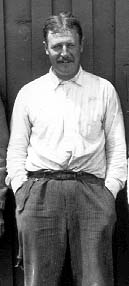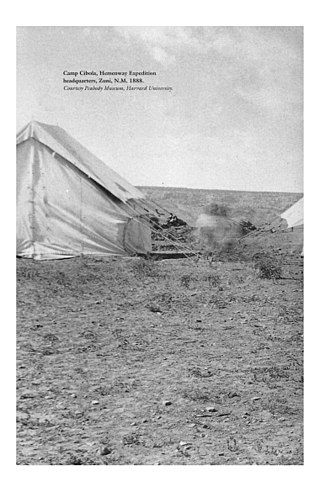
Hohokam was a culture in the North American Southwest in what is now part of south-central Arizona, United States, and Sonora, Mexico. It existed between 300 and 1500 CE, with cultural precursors possibly as early as 300 BCE. Archaeologists disagree about whether communities that practiced the culture were related or politically united. According to local oral tradition, Hohokam societies may be the ancestors of the historic Akimel and Tohono Oʼodham in Southern Arizona.

Mogollon culture is an archaeological culture of Native American peoples from Southern New Mexico and Arizona, Northern Sonora and Chihuahua, and Western Texas. The northern part of this region is Oasisamerica, while the southern span of the Mogollon culture is known as Aridoamerica.

The Hohokam Pima National Monument is an ancient Hohokam village within the Gila River Indian Community, near present-day Sacaton, Arizona. The monument features the archaeological site Snaketown 30 miles (48 km) southeast of Phoenix, Arizona, designated a National Historic Landmark in 1964. The area was further protected by declaring it a national monument in 1972, and was listed on the National Register of Historic Places in 1974.

Alfred Vincent Kidder was an American archaeologist considered the foremost of the southwestern United States and Mesoamerica during the first half of the 20th century. He saw a disciplined system of archaeological techniques as a means to extend the principles of anthropology into the prehistoric past and so was the originator of the first comprehensive, systematic approach to North American archaeology.

The Amerind Foundation is a museum and research facility dedicated to the preservation and interpretation of Native American cultures and their histories. Its facilities are located near the village of Dragoon in Cochise County, Arizona, about 65 miles east of Tucson in Texas Canyon.
Stephen Plog is an American archaeologist and anthropologist, who specializes in the pre-Columbian cultures of the American Southwest. As the Commonwealth Professor of Anthropology at The University of Virginia, he currently teaches undergraduate and graduate students, and is working to digitize all the research on the Chaco Canyon through the Chaco Research Archive. On May 1, 2006 he was elected to the National Academy of Sciences. Election to the academy is among the highest distinctions for a scientist, and is based on outstanding and ongoing achievements in original research. He was also a visiting fellow at the School of American Research in Santa Fe, New Mexico in 2001-2002.
Harold Sterling Gladwin (1883–1983) was an American archaeologist, anthropologist, and stockbroker.

Emil Walter "Doc" Haury was an American archaeologist who specialized in the archaeology of the American Southwest. He is most famous for his work at Snaketown, a Hohokam site in Arizona.
Southwestern archaeology is a branch of archaeology concerned with the Southwestern United States and Northwestern Mexico. This region was first occupied by hunter-gatherers, and thousands of years later by advanced civilizations, such as the Ancestral Puebloans, the Hohokam, and the Mogollon.
Charles Corradino Di Peso was an American archaeologist. He is known for his research in Northern Mexico and the American Southwest.

The Double Adobe site is an archaeological site in southern Arizona, twelve miles northwest of Douglas in the Whitewater Draw area. In October 1926, just three months after the first human artifact was uncovered at the Folsom site, Byron Cummings, first Head of the Archaeology Department at the University of Arizona, led four students to Whitewater Draw. Discovered by a schoolboy, the Double Adobe site contained the skull of a mammoth overlying a sand layer containing stone artifacts. One of these students was Emil Haury.

The Lehner Mammoth-Kill Site is in southern Arizona on the west bank of the San Pedro River 1.5 miles southwest of the town of Hereford. It is significant for its association with evidence that mammoths were killed here by Paleo-Indians 11,000 to 12,000 years before present.

The Point of Pines Sites are a set of archaeological sites on the San Carlos Apache Indian Reservation in the U.S. state of Arizona. Located around the settlement of Point of Pines, they are significant for associations with Ancestral Pueblo, Mogollon and Hohokam cultures. The sites were chosen as a field school location by Dr. Emil Haury because of the unusual presence of all three major prehistoric cultures of Arizona. The field school ran from 1946 to 1960, collecting large amounts of evidence from numerous sites. The site were collectively declared a National Historic Landmark in 1964.

Pueblo Grande Ruin and Irrigation Sites are pre-Columbian archaeological sites and ruins, located in Phoenix, Arizona. They include a prehistoric platform mound and irrigation canals. The City of Phoenix manages these resources as the S’edav Va’aki Museum.

John Otis Brew, was an American archaeologist of the American Southwest and director at the Peabody Museum at Harvard University. Many of his publications are still used today by archaeologists that conduct their work in the American Southwest. J.O. Brew was a titan in the world of archaeology for his attempts to "preserve our archaeological heritage".

The Naco Mammoth Kill Site is an archaeological site in southeast Arizona, 1 mile northwest of Naco in Cochise County. The site was reported to the Arizona State Museum in September 1951 by Marc Navarrete, a local resident, after his father found two Clovis points in Greenbush Draw, while digging out the fossil bones of a mammoth. Emil Haury excavated the Naco mammoth site in April 1952. In only five days, Haury recovered the remains of a Columbian Mammoth in association with 8 Clovis points. The excavator believed the assemblage to date from about 10,000 Before Present. An additional point was found in the arroyo upstream. The Naco site was the first Clovis mammoth kill association to be identified. An additional, unpublished, second excavation occurred in 1953 which doubled the area of the original work and found bones from a 2nd mammoth. In 2020, small charcoal fragments were found adhered to a mammoth bone from the site. AMS radiocarbon dating produced a mean date of 10,985 ± 56 Before Present.
Paul Sidney Martin was an American anthropologist and archaeologist. A lifelong associate of the Field Museum of Natural History in Chicago, Martin studied pre-Columbian cultures of the Southwestern United States. He excavated more than a hundred archaeological sites, starting with the groundbreaking seven-season expedition to the Montezuma County, Colorado in 1930–1938. His research passed through three distinct stages: field archaeology of the Anasazi Pueblo cultures of Colorado in the 1930s, studies of the Mogollon culture in 1939–1955 and the New Archaeology studies in 1956–1972. Martin collected more than 585 thousand archaeological artifacts although his own methods of handling these relics were at times destructive and unacceptable even by the standards of his time.
Bailey Ruin is an archaeological site located in Navajo County, Arizona, United States. The site, also known as "Stott Ranch Ruin" and "Pope Ranch Site," was added to the National Register of Historic Places on March 17, 2006 for its historical and archaeological significance.

The Hemenway Southwestern Archaeological Expedition occurred between 1886 and 1894 in the American Southwest. Sponsored by Mary Tileston Hemenway, a wealthy widow and philanthropist, the expedition was initially led by Frank Hamilton Cushing, who was replaced in 1889 by Jesse Walter Fewkes. It was considered to be a major scientific archaeological expedition, notable for the discovery of the prehistoric Hohokam culture.
Clara Lee Tanner was an American anthropologist, editor and art historian. She is known for studies of the arts and crafts of American Indians of the Southwest.












